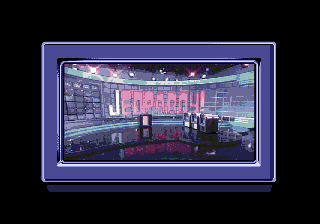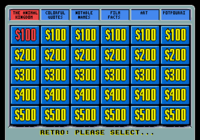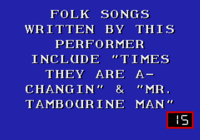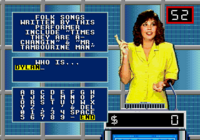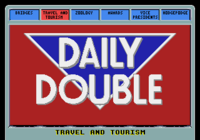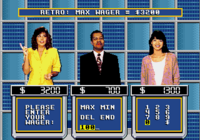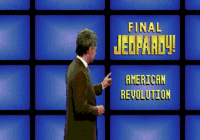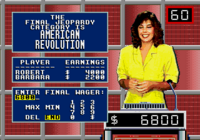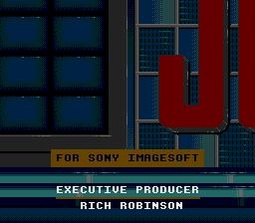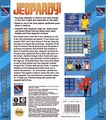Jeopardy! (Mega-CD)
From Sega Retro
- For the Sega Mega Drive and Sega Game Gear versions by GameTek, see Jeopardy! (GameTek).
| Jeopardy! | ||||||||||
|---|---|---|---|---|---|---|---|---|---|---|
| System(s): Sega Mega-CD | ||||||||||
| Publisher: Sony Imagesoft | ||||||||||
| Developer: Absolute Entertainment | ||||||||||
| Licensor: Columbia TriStar Television | ||||||||||
| Peripherals supported: Team Player | ||||||||||
| Genre: Table | ||||||||||
| Number of players: 1-3 (alternating) | ||||||||||
|
The Sega Mega-CD version of Jeopardy! was handled by rightsholders Sony themselves through Sony Imagesoft with Absolute Entertainment rather than GameTek, who made versions on other systems. The Mega-CD version was released in the US in 1993, with a planned European version[1] failing to see release.
Compared to its cartridge counterparts, this version features recorded videos and animations of host Alex Trebek and the model contestants rather than still images. It also includes more voice samples (though category names and clues are not read out). However, it plays largely the same.
Contents
Gameplay
The game is an adaptation of the long-running American quiz show Jeopardy! that can be played by up to three contestants (which can be any combination of human- or computer-controlled). Multiplayer games can be played with separate control pads (using a Team Player for three-player games) or sharing one or two control pads. Players can choose from six different actors to represent them in short video clips. The game saves the progress of up to three different games to the console's internal memory so they can be continued later.
Each game consists of three rounds: Jeopardy!, Double Jeopardy!, and Final Jeopardy! The first two rounds feature a large game board consisting of six categories with five clues each (for a total of 30 clues per round) covering a variety of topics such as history, pop culture, or literature. The name of the category sometimes suggests the form that the response should take (such as "Name the Author" or "Starts with 'H'"). Clues are valued by dollar amounts from lowest to highest, roughly increasing in difficulty.
The player in control of the board (initially the first player but subsequently whichever contestant last successfully answered a question) can choose any clue from any category. The contestants are then presented with a trivia clue phrased as an answer. After a brief delay to give players time to read the clue, players are given 15 seconds to "buzz in." When using separate control pads, players buzz in with ![]() . When using a single control pad for a two- or three-player game,
. When using a single control pad for a two- or three-player game, ![]() buzzes in for contestant one,
buzzes in for contestant one, ![]() for contestant two, and
for contestant two, and ![]() for contestant three. When using two control pads for a three-player game,
for contestant three. When using two control pads for a three-player game, ![]() on the first control pad buzzes in for contestant one,
on the first control pad buzzes in for contestant one, ![]() on the second control pad buzzes in for contestant two, and
on the second control pad buzzes in for contestant two, and ![]() on the second control pad buzzes in for contestant three.
on the second control pad buzzes in for contestant three.
When a contestant buzzes in, that player is given 60 seconds to respond to the clue by typing an answer (which the game will phrase in the form of a question). The D-Pad highlights a character, ![]() selects it,
selects it, ![]() deletes the last character, and
deletes the last character, and ![]() submits the answer. The game sometimes accepts more than one possible way of phrasing the answer (for example, it will accept both "Spiro Agnew" and "Agnew," "Brooklyn Bridge" and "Brooklyn," or sometimes even abbreviations such as "CT" for "Connecticut"). However, answers must be spelled correctly. Answering correctly awards the player the value of the clue and allows the player to select the next clue. Answering incorrectly (or not answering at all within the time limit) costs the player the value of the clue (potentially giving the player a negative score) and gives the other players an opportunity to buzz in. Computer players have a chance of buzzing in for each question. When they do buzz in, they may answer correctly or fail to respond at all. If nobody provides a correct response, the game shows the answer. The Double Jeopardy! round plays the same as the first round, but the categories are different and the values of the clues are doubled.
submits the answer. The game sometimes accepts more than one possible way of phrasing the answer (for example, it will accept both "Spiro Agnew" and "Agnew," "Brooklyn Bridge" and "Brooklyn," or sometimes even abbreviations such as "CT" for "Connecticut"). However, answers must be spelled correctly. Answering correctly awards the player the value of the clue and allows the player to select the next clue. Answering incorrectly (or not answering at all within the time limit) costs the player the value of the clue (potentially giving the player a negative score) and gives the other players an opportunity to buzz in. Computer players have a chance of buzzing in for each question. When they do buzz in, they may answer correctly or fail to respond at all. If nobody provides a correct response, the game shows the answer. The Double Jeopardy! round plays the same as the first round, but the categories are different and the values of the clues are doubled.
A "Daily Double" clue is hidden behind one clue in the Jeopardy! round and two in Double Jeopardy! Before the clue is revealed, the contestant who has selected the Daily Double must declare a wager, from a minimum of $5 to a maximum of their entire score or the highest clue value available in the round, whichever is greater. Only the contestant who chooses the Daily Double can answer the clue. A correct response adds the value of the wager to the contestant's score while an incorrect response (or failure to respond) deducts the same value. Whether or not the contestant responds correctly, they choose the next clue.
The first two rounds end when every clue has been chosen. The Final Jeopardy! round features a single clue, chosen at random. Only contestants with at least $1 in winnings continue to this round. Players are given the category of the clue in advance. Each player chooses a wager as low as nothing or as high as their total winnings. The contestants are then given the clue and must answer individually. In the television program, each contestant's wager and response is hidden until they have all finished responding. The game suggests that the other players not watch the screen while another player is responding to preserve the same surprise. Computer players have their wagers and responses obscured. After the Final Jeopardy! round concludes, the player with the most money won wins the game.
Production credits
- Executive Producer: Rich Robinson
- Producer: Mary Ann Norris
- Assistant Producers: David Poe, Patrick Goodman
- Testers: Jose Cruz, Steve Ceragioli, Andre Leighton, Andrew Stein, Jody Kelsey, Seth Luisi, Bruce Cochrane, Tobin Russell, C.J. Connoy, Kurt Schwengel
- Creative Director: Carol Albert
- Technical Director: Roger Booth
- Programming: Jonathan Eiten
- Support Programming: Shen Jian Long, Chi Y. Chan, Michael D. Fernie
- System Software: Rick Booth, Dennis Benson, David Minogue
- Audio: Mark Van Hecke, Jim Wallace, Steve Melillo
- Multi-Media: Mike Sullivan
- Testing: Robert Prescott, Alan Deloach, Ezra Blau, Keith Blumenstock, Bayani Caes, Andre Garcia, Arvee Garde, Jonathan Ross, Aaron Townly
Magazine articles
- Main article: Jeopardy! (Mega-CD)/Magazine articles.
Promotional material
also published in:
- GamePro (US) #64: "November 1994" (1994-xx-xx)[3]
- Electronic Gaming Monthly (US) #65: "December 1994" (1994-xx-xx)[4]
Physical scans
| Sega Retro Average | |||||||||||||||||||
|---|---|---|---|---|---|---|---|---|---|---|---|---|---|---|---|---|---|---|---|
|
| 60 | |
|---|---|
| Based on 3 reviews | |
Technical information
- Main article: Jeopardy! (Mega-CD)/Technical information.
References
- ↑ Sega Pro, "Xmas Special 1993" (UK; 1993-12-02), page 100
- ↑ File:Jeopardy MCD credits.pdf
- ↑ GamePro, "November 1994" (US; 1994-xx-xx), page 269
- ↑ Electronic Gaming Monthly, "December 1994" (US; 1994-xx-xx), page 167
- ↑ Electronic Games (1992-1995), "April 1995" (US; 1995-0x-xx), page 76
- ↑ GamePro, "April 1995" (US; 1995-xx-xx), page 54
- ↑ VideoGames, "March 1995" (US; 1995-02-xx), page 85
| Jeopardy! (Mega-CD) | |
|---|---|
|
Main page | Magazine articles | Reception | Technical information | |
